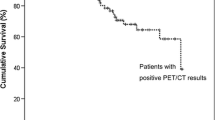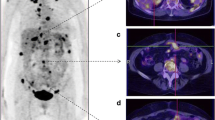Abstract
Purpose
To evaluate the prognostic significance of increased mediastinal 18F-FDG uptake in PET/CT for the staging of advanced ovarian cancer.
Methods
We retrospectively evaluated patients managed for FIGO stage III/IV ovarian cancer between 1 January 2006 and 1 June 2009. Patients were included if they had undergone 18F-FDG PET/CT and surgery for initial staging. Exclusion criteria were age younger than 18 years, inability to undergo general anaesthesia, recurrent ovarian cancer, and borderline or nonepithelial malignancy. Whole-body PET/CT was performed after intravenous 18F-FDG injection. The location of abnormal hot spots and 18F-FDG maximal standard uptake values (SUVmax) were recorded. We compared the complete cytoreduction and survival rates in groups defined based on mediastinal 18F-FDG uptake and SUVmax values. Kaplan-Meier curves of overall survival and disease-free survival were compared using the log-rank test. Hazard ratios with their 95% confidence intervals were computed. Adjusted hazard ratios were obtained using a multivariate Cox model.
Results
We included 53 patients, of whom 17 (32%) had increased mediastinal 18F-FDG uptake. Complete cytoreduction was achieved in 14 (87.5%) of the 16 patients managed with primary surgery and in 21 (75%) of the 28 patients managed with interval surgery. Complete cytoreduction was achieved significantly more often among patients without increased mediastinal 18F-FDG uptake (80.6% vs. 35.3%; p = 0.001). Disease-free survival was comparable between the two groups. By univariate analysis, overall mortality was significantly higher among patients with increased mediastinal 18F-FDG uptake (hazard ratio 5.70, 95% confidence interval 1.74–18.6). The only factor significantly associated with overall survival by multivariate analysis was complete cytoreduction (adjusted hazard ratio 0.24, 95% confidence interval 0.07–0.89).
Conclusion
Increased mediastinal 18F-FDG uptake was common in patients with advanced ovarian cancer. However, complete cytoreduction, which was significantly more frequent among patients without mediastinal 18F-FDG uptake, was the only factor independently associated with survival.



Similar content being viewed by others
References
Bristow RE, Tomacruz RS, Armstrong DK, Trimble EL, Montz FJ. Survival effect of maximal cytoreductive surgery for advanced ovarian carcinoma during the platinum era: a meta-analysis. J Clin Oncol. 2002;20:1248–59.
Eisenkop SM, Spirtos NM, Friedman RL, Lin WC, Pisani AL, Perticucci S. Relative influences of tumor volume before surgery and the cytoreductive outcome on survival for patients with advanced ovarian cancer: a prospective study. Gynecol Oncol. 2003;90(2):390–6.
Chi DS, Eisenhauer EL, Lang J, Huh J, Haddad L, Abu-Rustum NR, et al. What is the optimal goal of primary cytoreductive surgery for bulky stage IIIC epithelial ovarian carcinoma (EOC)? Gynecol Oncol. 2006;103:559–64.
Choi HJ, Roh JW, Seo SS, Lee S, Kim JY, Kim SK, et al. Comparison of the accuracy of magnetic resonance imaging and positron emission tomography/computed tomography in the presurgical detection of lymph node metastases in patients with uterine cervical carcinoma: a prospective study. Cancer. 2006;106:914–22.
Kidd EA, Siegel BA, Dehdashti F, Grigsby PW. The standardized uptake value for F-18 fluorodeoxyglucose is a sensitive predictive biomarker for cervical cancer treatment response and survival. Cancer. 2007;110:1738–44.
Risum S, Høgdall C, Loft A, Berthelsen A, Høgdall E, Nedergaard L, et al. Prediction of suboptimal primary cytoreduction in primary ovarian cancer with combined positron emission tomography/computed tomography – a prospective study. Gynecol Oncol. 2008;108:265–70.
Avril N, Sassen S, Schmalfeldt B, Naehrig J, Rutke S, Weber W, et al. Prediction of response to neoadjuvant chemotherapy by sequential F-18-fluorodeoxyglucose positron emission tomography in patients with advanced-stage ovarian cancer. J Clin Oncol. 2005;23:7445–53.
Nam E, Yun M, Oh Y, Kim J, Kim J, Kim S, et al. Diagnosis and staging of primary ovarian cancer: correlation between PET/CT, Doppler US, and CT or MRI. Gynecol Oncol. 2010;116:389–94.
Risum S, Høgdall C, Loft A, Berthelsen A, Høgdall E, Nedergaard L, et al. Does the use of diagnostic PET/CT cause stage migration in patients with primary advanced ovarian cancer? Gynecol Oncol. 2010;116:395–8.
Deffieux X, Castaigne D, Pomel C. Role of laparoscopy to evaluate candidates for complete cytoreduction in advanced stages of epithelial ovarian cancer. Int J Gynecol Cancer. 2006;16 Suppl 1:35–40.
Chi DS, Abu-Rustum NR, Sonoda Y, Chen SW, Flores RM, Downey R, et al. The benefit of video-assisted thoracoscopic surgery before planned abdominal exploration in patients with suspected advanced ovarian cancer and moderate to large pleural effusions. Gynecol Oncol. 2004;94:307–11.
Cohen-Mouly S, Badia A, Bats AS, Barthes F, Bensaid C, Riquet M, et al. Role of video-assisted thoracoscopy in patients with ovarian cancer and pleural effusion. Int J Gynecol Cancer. 2009;19:1662–5.
Kolev V, Mironov S, Mironov O, Ishill N, Moskowitz C, Gardner G, et al. Prognostic significance of supradiaphragmatic lymphadenopathy identified on preoperative computed tomography scan in patients undergoing primary cytoreduction for advanced epithelial ovarian cancer. Int J Gynecol Cancer. 2010;20:979–84.
Souilamas R, Hidden G, Riquet M. Mediastinal lymphatic efferents from the diaphragm. Surg Radiol Anat. 2001;23:159–62.
Okiemy G, Foucault C, Avisse C, Hidden G, Riquet M. Lymphatic drainage of the diaphragmatic pleura to the peritracheobronchial lymph nodes. Surg Radiol Anat. 2003;25:32–5.
Rosenbaum SJ, Lind T, Antoch G, Bockisch A. False-positive FDG PET uptake – the role of PET/CT. Eur Radiol. 2006;16(5):1054–65.
Lim M, Lee H, Jung D, Choi J, Seo S, Park S. Pathological diagnosis and cytoreduction of cardiophrenic lymph node and pleural metastasis in ovarian cancer patients using video-assisted thoracic surgery. Ann Surg Oncol. 2009;16:1990–6.
Conflicts of interest
None.
Author information
Authors and Affiliations
Corresponding author
Rights and permissions
About this article
Cite this article
Bats, AS., Hugonnet, F., Huchon, C. et al. Prognostic significance of mediastinal 18F-FDG uptake in PET/CT in advanced ovarian cancer. Eur J Nucl Med Mol Imaging 39, 474–480 (2012). https://doi.org/10.1007/s00259-011-1984-9
Received:
Accepted:
Published:
Issue Date:
DOI: https://doi.org/10.1007/s00259-011-1984-9




